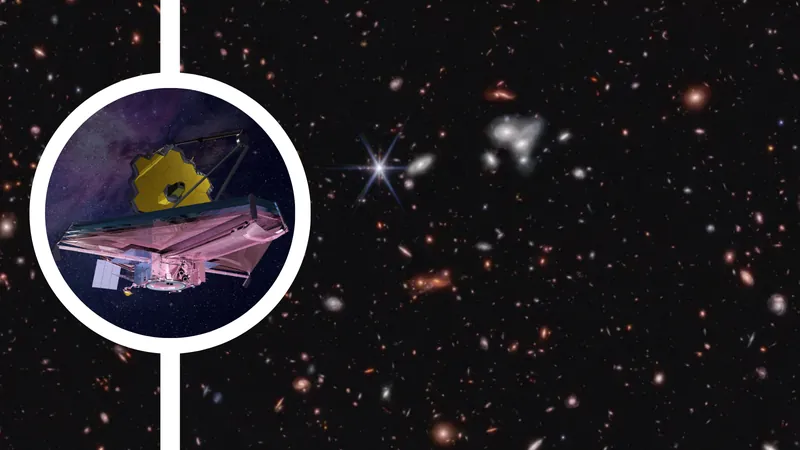
What Happens If We Find Nothing in the Search for Alien Life? Groundbreaking Research Offers Surprising Insights!
2025-04-07
Author: Wei
What Happens If We Find Nothing in the Search for Alien Life?
As humanity continues its quest to discover life beyond our planet, a daunting possibility arises: what if our explorations yield no evidence of extraterrestrial life at all? A groundbreaking study led by Dr. Daniel Angerhausen, a physicist from ETH Zurich’s Exoplanets and Habitability Group and a SETI Institute affiliate, shines light on this very issue, suggesting that negative results could still provide significant insights into the cosmos.
Published in The Astronomical Journal, the research forms part of the Swiss National Center of Competence in Research, PlanetS. By employing Bayesian statistical analysis, Angerhausen and his team determined how many exoplanets must be studied to glean meaningful conclusions regarding the frequency of potentially habitable worlds.
Unveiling the Unknown: The Significance of Silence
The findings are striking—if scientists analyze between 40 to 80 exoplanets and confirm a “perfect” no-detection outcome, they could reasonably conclude that merely 10% to 20% of similar planets might support life. In the sprawling Milky Way, this figure translates to a staggering 10 billion potentially habitable worlds. Such results would allow researchers to establish a crucial upper limit on the presence of life in the universe, a goal that has long eluded scientists.
However, determining these limits comes with challenges. Each observation carries inherent uncertainties that can significantly impact the conclusions drawn. For instance, the phenomenon of “interpretation uncertainty” suggests there’s a risk of missing subtle biosignatures, thereby misclassifying a planet as uninhabitable. Additionally, sample uncertainty can compromise the integrity of our planet selections during studies, potentially skewing results.
The Art of Inquiry: Asking the Right Questions
"It's not merely a numbers game; we must focus on the right questions and understand how confident we can be in our observations," Angerhausen remarks. He warns that an overestimation of our current capabilities may lead to misleading insights even from extensive surveys.
Such caution is essential for forthcoming missions, including the ambitious Large Interferometer for Exoplanets (LIFE), spearheaded by ETH Zurich. This mission is designed to investigate dozens of exoplanets with Earth-like mass, radius, and temperatures, analyzing their atmospheres for signs of life-indicative elements like water and oxygen.
Fortunately, the LIFE mission plans to conduct enough observations to arrive at significant conclusions about the likelihood of life in our galactic vicinity. Nevertheless, the study underscores the crucial need for thorough uncertainty and bias assessments to maintain the validity of any findings.
Navigating Statistical Landscapes: Prior Knowledge Matters
Additionally, Angerhausen’s team explored the influence of prior knowledge—previous understandings in statistical terms—on the results of future observations. Their comparisons between Bayesian and Frequentist statistical methods reveal that while priors can affect outcomes, the sample sizes targeted by missions like LIFE yield comparable results across both frameworks.
Co-author Emily Garvin, currently pursuing her Ph.D. in Angerhausen's group, emphasizes the importance of selecting the right statistical techniques tailored to specific research objectives. "Different scientific goals might necessitate different statistical methods," she explains, further indicating that a varied approach could reveal complementary insights from the same dataset.
A Universe of Possibilities: What Lies Ahead?
This pivotal research emphasizes the importance of crafting precise scientific questions, selecting appropriate methodologies, and implementing robust sampling designs for interpreting study outcomes effectively. “A single positive detection would forever alter our understanding of the universe,” Angerhausen concludes. “However, even in the absence of evidence for life, we can still grasp how rare—or perhaps how common—planets with detectable biosignatures truly might be.”
As we stand on the cusp of discovering potentially life-bearing worlds, this study reminds us that even silence can teach us invaluable lessons about our place in the cosmos. Will we finally unravel the mysteries of life in the universe, or will the echoes of our exploration lead to more questions than answers? The search continues!

 Brasil (PT)
Brasil (PT)
 Canada (EN)
Canada (EN)
 Chile (ES)
Chile (ES)
 Česko (CS)
Česko (CS)
 대한민국 (KO)
대한민국 (KO)
 España (ES)
España (ES)
 France (FR)
France (FR)
 Hong Kong (EN)
Hong Kong (EN)
 Italia (IT)
Italia (IT)
 日本 (JA)
日本 (JA)
 Magyarország (HU)
Magyarország (HU)
 Norge (NO)
Norge (NO)
 Polska (PL)
Polska (PL)
 Schweiz (DE)
Schweiz (DE)
 Singapore (EN)
Singapore (EN)
 Sverige (SV)
Sverige (SV)
 Suomi (FI)
Suomi (FI)
 Türkiye (TR)
Türkiye (TR)
 الإمارات العربية المتحدة (AR)
الإمارات العربية المتحدة (AR)